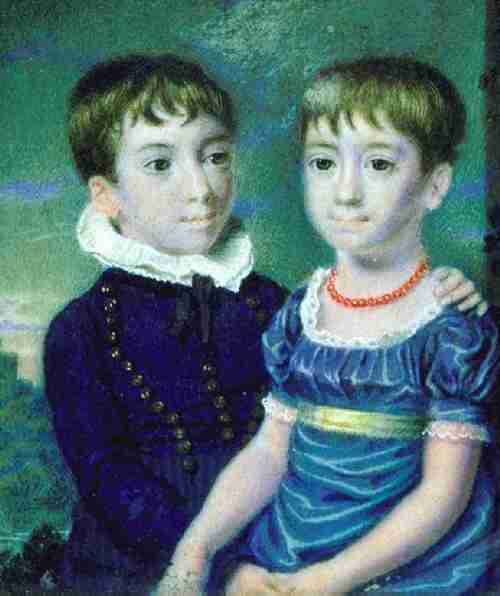
Figure 1.--This English boy was painted with his sister in the early 19th century. Note the double breasted style of his skeleton suit. |

|
Skeleton suits were widely worn througout Europe and America in the late 18th and early 19th century. We are not sure yet in which country they first appeared or who designed them. I believe that it was probably France, which was already setting clothing and hair styles throughout Europe. Skeleton suits were also very popular in England and many other countries. Besides England I have seen paintings of American Italian, and Spanish boys wearing skeleton suits and they were probably worn in many other countries as well. I do not think, however, the style originated in these countries. Skeleton suits were especially popular in England and even mentioned in Dickens novels. Many basic styles had a variety of stylistic variations and different chronological time lines in popularity among the different countries where they were worn. HBC has not yet, however, been able to detect stylistic differences aming different countries. HBC's initial conclusion is that the skeketon was a kind of pan-European style for boys. The topic of national differences in skeleton suits, however, requires much further investigation.
We note American boys wearing skeleton suits. America at the tiome of course was a fashion backwater. Affluent families in America primarily just followed popular styles in Europe, primarily England and France. The population of America was very small at the time. The population in cities, where boys from fashionable families were most likely to wear skeleton suits, was especially small. A good example is Charles Mosley in 1791. His bright red velvet skeleton suit looks just like the ones by European boys from affluent families. We note an unidentified boy painted about 1810.
Austria in the 19th century was an large miulti-ethnic empire and one of the great powers. We see Austrian boys wearing skeleton suits in the early 19th century. A good example is the Odolek boys (1826). We were not sure about the chronological range of the skeleton suit. Here we see them still being worn by boys from a fashionable Autrian family.
Skeleton suits werecfthe first outdits mean specifically to be worn by boys. Before the skeleton suit appeares in the late-18th century. boys wore dresses like their sisters and after breeching scaled down outfits based on the styles their fathers were wearing. Skeleton suits seem especially popular in England and even mentioned in Dickens novels, like David Copperfield. we see more boys wearing skelton suits in England than any any oyher country. In the era before photofgraphy, however, this is diffucult to assess wih any validity. Many portaits of children painted in the late-18th and early-19th century show the boys wearing skeleton suits. Often brothers were dressed in identical suits. There do not appear to have been specific national styles, but rathr atyule worn by boys from well-to-do familes across western Europe and the United states. We are not yet sure about the age range. we see a lot of younger boys wearing skeleton suits, but believe they were fairly common for pre-teen boys.
We are not sure yet in which country the skeleton suit first appeared or who designed them. We believe, however, that it was probably France, which was already setting clothing and hair styles throughout Europe. French fashions clearly set the standard for women's fashions. This dominance was not as apparent for makle fashions. Here we bekieve the British had considrable impact. We are less sure abouut children's fashions, especially boys' fashions. We see European royalty and the aristocracy dressing boys in skeleton suits after breeching. This of course included the French. The epitome of a dressy, formalmoccassion was the coronstion of Napoleon Bonaparte as emperor (1804). And among all the fashionably dressed notables in attendance was one boy in a red velvet skeleton suit. The sleleton suit was the first dedicated garment for children--in this case boys. It would take some time before dedicated garmets for girls appeared. They continued to wear smaller versions of the dresses that their mothers wore for some time. About the same time the issue of the very nature of childhood was being addressed in Europe. French authors in the late-18th century had begun to address the question of child raising and education. The most famous was Rosseau and his classic Emile. They advanced the idea that children should wear unique clothing designed to accomodate their special needs.
HBC has so far been unable to find any information on German skeleton suits.
HBC has noted some paintings of Italian princes and other nobel boys dressed in skeleton suits
We notice boys from wealthy families in the late 18th century wearing skeleton suits. Walter Otto Fergusson Tepper was the son of King Stanislaw II's banker.
We note boys from wealthy families wearing skeleton suits in the late 18th century. One boy was
HBC has noted some paintings of Spanish princes and other nobel boys dressed in skeleton suits.
Navigate the Boys' Historical Clothing Web Site:
[Return to the Main skelton suit page]
[About Us]
[Introduction]
[Activities]
[Biographies]
[Chronology]
[Cloth and textiles]
[Countries]
[Garments]
[Girls]
[Photography]
[Topics]
[Bibliographies]
[Contributions]
[FAQs]
[Glossaries]
[Images]
[Links]
[Registration]
[Search]
[Tools]
[Boys' Clothing Home]
